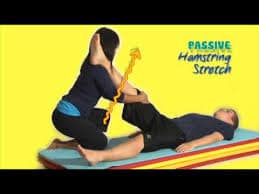Stretching is an important aspect to every health and wellness program, whether you’re recovering from injury, maintaining your health or anywhere in between.
Stretching helps the body to achieve balance, improve the joints range of motion, and increase flexibility.
There are two types of stretching exercises commonly performed at the completion of a remedial massage and/or a sports massage treatment.
These are as follows:
- Static / Passive Stretching.
- PNF Stretching (Proprioceptive neuromuscular facilitation).
Static / Passive
The stretch position is held for 30 – 60 seconds and when there is a subsequent muscle relaxation, the muscle can then be stretched a little further, again without discomfort. This method produces the least amount of tension and is probably the safest method of increasing flexibility.
At the completion of a remedial massage or sports massage session, if required, I will provide you with the necessary information on the appropriate stretches for you to perform at home.
For home stretches, simply hold your stretch for 20 – 30 seconds, in a comfortable position. Stretching to a point where you can feel the muscle stretching, but no pain. If you experience pain, you’ve stretched too far and be at risk of injury.
PNF is a little more complex than static stretching, but it’s generally considered the most effective form of stretching to increase flexibility. This form of stretching is often used to gently improve the joints range of motion. Usually PNF stretching involves two people, one who is stretching and the other assisting and applying resistance, however it can also be performed on your own, although it may not be as effective.
There are a number of PNF methods, a common method is the:
“Hold-Relax” technique, which is also called the “Contract-Relax” technique. Starting in a passive stretch position, the muscle is isometrically contracted for 7 – 15 seconds, then relaxed for 2 -3 seconds, then passively stretched for around 10 – 15 seconds. This may be repeated another 2 times.
The purpose of stretching
The purpose of stretching a muscle is to increase flexibility at the joint in an attempt to develop/maintain a full range of movement.
This appears to:
- Decrease the incidence of muscular and tendinous injuries
- Minimize and alleviate muscle soreness
- Enhance athletic performance
Principles of Stretching
- The muscle must be taken to its fully stretched position and this must be done slowly, gently and frequently.
Slowly means that while the exercise is being done the muscle being stretched must be moved slowly so that you can easily be aware of the tension in the muscle even when it is quite light.
Gently means that, when stretching, the tension in the muscle is mild enough that if the position is held for 20 – 30 seconds the tightness should disappear. If it hasn’t, then the amount of tension is too much so you need to relax the muscle then repeat the exercise using less tension.
Frequently means that to be effective, the stretching should be done several times per day. When you are trying to improve flexibility in a muscle you should do the exercise in sets of 10 and do at least four sets in the course of the day. It is more effective to do these exercises several times per day rather than doing all four sets at once. Once you have achieved the flexibility you require, doing the exercise once or twice a day will be sufficient to maintain the flexibility.
- The stretch must be held for at least thirty seconds before being taken further
- The stretch should be taken to the point of tension but never pain.
- The stretch should not involve jerky/bouncing movements at the end of range.
- Watch for muscle spasms or any cues which may indicate inappropriate stretching techniques.
To View all our Services Areas Click Here





